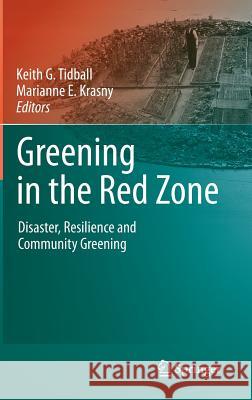Greening in the Red Zone: Disaster, Resilience and Community Greening » książka
Greening in the Red Zone: Disaster, Resilience and Community Greening
ISBN-13: 9789048199464 / Angielski / Twarda / 2013 / 503 str.
Access to green space and the act of creating green spaces is well understood to promote human health, especially in therapeutic contexts among individuals suffering traumatic events. Less well understood, though currently being studied, is the role of access to green space and the act of creating and caring for it in promoting neighborhood health and well being as related to social-ecological system resilience. An important implication of Greening in the Red Zone lies in specific instances of greening and the presence of greened spaces in promoting and enhancing recovery, and perhaps resilience, in social-ecological systems disrupted or perturbed by violent conflict or other catastrophic disaster. This edited volume provides illustration and interpretation of these phenomena through a series of cases or examples of Greening in the Red Zone, which will explore how access to green space and the act of creating green spaces in extreme situations might contribute to resistance, recovery, and resilience of social-ecological systems. Greening in the Red Zone takes important steps in advancing our understanding of what makes communities bounce back from disaster or violent conflict. The authors findings that creating an caring for green space contributes positively to recovery and resilience adds to the toolkit of those working in disaster and conflict zones. William C. Banks, Director,
Institute for National Security and Counterterrorism,
Syracuse UniversityGreening in the Red Zone" is an important and highly relevant book. It provides theoretical understanding and scientific evidence of the healing and therapeutic power of contact with nature, especially during times of crisis, sickness and loss. At a time when society is more separated than ever from the natural world, it offers additional reason why our ongoing experience of nature is essential for the human body, mind and spirit. This book is both instructive and inspiring.Stephen R. Kellert,
Tweedy Ordway Professor Emeritus,
Senior Research Scholar,
Yale UniversityGreening in the Red Zone is a fascinating book that greatly elevates our understanding of how the perspective of humans as an integrated part of nature may contribute to the resilience discourse. This multi-authored volume provides numerous examples of how greening and the presence of green spaces in areas that have experienced large disturbances or catastrophic events may reduce trauma among individuals and enhance recovery and resilience in human communities. I certainly warmly recommend this book to anyone interested in how we may prepare ourselves for an increasingly uncertain future, building resilience in social-ecological systems.Thomas Elmqvist,
Department of Systems Ecology, and
Stockholm Resilience Centre, Stockholm University"











